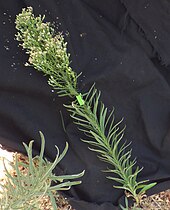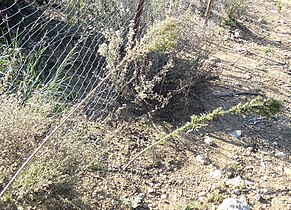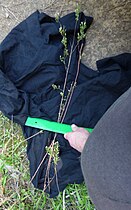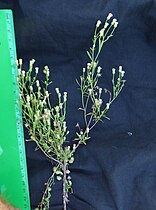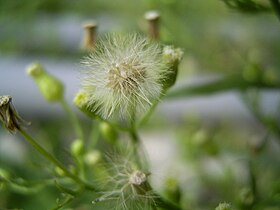| Erigeron canadensis | |
|---|---|

| |
| Scientific classification | |
| Kingdom: | Plantae |
| Clade: | Tracheophytes |
| Clade: | Angiosperms |
| Clade: | Eudicots |
| Clade: | Asterids |
| Order: | Asterales |
| Family: | Asteraceae |
| Genus: | Erigeron |
| Species: | E. canadensis
|
| Binomial name | |
| Erigeron canadensis | |
| Synonyms[1] | |
|
Alphabetical list
| |

Erigeron canadensis (synonym Conyza canadensis) is an annual plant native throughout most of North America and Central America. It is also widely naturalized in Eurasia and Australia. Common names include horseweed, Canadian horseweed, Canadian fleabane, coltstail, marestail, and butterweed. It was the first weed to have developed glyphosate resistance, reported in 2001 from Delaware.
Description
Erigeron canadensis is an annual, herbaceous plant growing to 1.5 metres (5 feet) tall, with sparsely hairy stems. The leaves are unstalked, slender, 2–10 centimetres (0.8–3.9 inches) long, and up to 1 cm (0.4 in) wide, with a coarsely toothed margin. They grow in an alternate spiral up the stem, and the lower ones wither early. The flower heads are produced in dense inflorescences and are 1 cm (0.4 in) in diameter. Each individual flower has a ring of white or pale purple ray florets and a centre of yellow disc florets. The fruit is a cypsela tipped with dirty white down.[2]
Erigeron canadensis can easily be confused with Erigeron sumatrensis, which may grow to a height of 2 m (6.6 ft), and the more hairy Erigeron bonariensis, which does not exceed 1 m (3.3 ft). E. canadensis is distinguished by bracts that have a brownish inner surface with no red dot at the tip, and are free (or nearly free) of the hairs found on the bracts of the other species.[3][4][5]
Distribution and habitat
Horseweed originated in North America and Central America and is widespread in its native range.[6] It has spread to inhabited areas of most of the temperate zone of Asia,[7] Europe,[2][8] and Australia.[9] It is found in Britain from northern Scotland to Cornwall, growing as a weed of arable land and man-made environments. It is considered invasive in China.[10]
Weed status
Horseweed is commonly considered a weed, and in Ohio, Oregon, and some other locations,[11] it has been declared a noxious weed.[12][13] It was the first weed to have developed glyphosate resistance, reported in 2001 from Delaware.[14]
It can be found in fields, meadows, and gardens throughout its native range. Horseweed infestations (specifically of 105 plants per 10 ft2) have reduced soybean yields by as much as 83%,[15] with one estimate claiming it can reduce yields by up to 90%.[16] Severe infestations have reduced sugar beet yields by 64%.[15]
It is an especially problematic weed in no-till agriculture, as it is often resistant to glyphosate[14] and other herbicides.[17] Farmers are advised to include 2,4-D or dicamba in a burndown application prior to planting to control horseweed.[18][19]
Uses
The Zuni people insert the crushed flowers of E. canadensis var. canadensis into the nostrils to cause sneezing, relieving rhinitis.[20] Other[who?] Native Americans have used a preparation of the plant's leaves to treat sore throat and dysentery.[21] A tincture can be made from the dried flowering tops of the plants.[citation needed]
Horseweed is a preferable material for use in the hand drill-method of making friction fire.[2][failed verification]
Gallery
Standard form
-
General form, may be light green, inflorescence fairly tight
-
Stemmy form
-
Flower head, hairless or mostly so, ray petals small but conspicuous, base of head not widely bulging
-
Flower head, angled
-
Flower head face on
-
Individual flowers in the head
-
Hair profile of leaf, projecting at base usually, directed forward at tip
-
Leaf tip with forward hairs not curving inward
-
Leaf surfaces not hairy
-
Leaf bases near stem showing projecting hairs
-
May become large
Other forms
-
Biennial growing in sand by a river from a surviving stem
-
Biennial with ad-hoc branching
-
Form with broken biennial stem top
-
Unusual spike-like form growing in winter
-
seeds
References
- ^ a b "Erigeron canadensis L." Plants of the World Online. Royal Botanic Gardens, Kew. Retrieved 2020-08-16.
- ^ a b c "Canadian Fleabane: Conyza canadensis". NatureGate. Retrieved 2013-12-31.
- ^ Conyza sumatrensis, International Environmental Weed Foundation.
- ^ Green, Deane (31 August 2011). "Horseweed, Marestail". Retrieved 2014-08-09.
- ^ Flora of North America, Conyza canadensis (Linnaeus) Cronquist, Bull. Torrey Bot. Club. 70: 632. 1943. Vergerette du Canada.
- ^ Biota of North America Program, 2014 county distribution map, Erigeron canadensis.
- ^ Flora of China, Erigeron canadensis Linnaeus, Sp. Pl. 2: 863. 1753. 小蓬草 xiao peng cao
- ^ Altervista Flora Italiana, Cespica canadese, avoadinha, Berufkraut, Erigeron canadensis L. includes photos and European distribution map
- ^ Atlas of Living Australia, Conyza canadensis (L.) Cronquist Canadian Fleabane
- ^ Wu, Bingde; Zhang, Huanshi; Jiang, Kun; Zhou, Jiawei; Wang, Congyan (2019). "Erigeron canadensis affects the taxonomic and functional diversity of plant communities in two climate zones in the North of China". Ecological Research. 34 (4): 535–547. Bibcode:2019EcoR...34..535W. doi:10.1111/1440-1703.12024. S2CID 198244222.
- ^ "Appendix H.Noxious and Invasive WeedControlPlan" (PDF).
- ^ "Erigeron canadensis". Germplasm Resources Information Network. Agricultural Research Service, United States Department of Agriculture. Retrieved 2017-12-18.
- ^ "Noxious Weed Program | Deschutes County Oregon". www.deschutes.org. Retrieved 2023-06-13.
- ^ a b VanGessel, Mark J. (2001). "Glyphosate-resistant horseweed from Delaware". Weed Science. 49 (6): 703–705. doi:10.1614/0043-1745(2001)049[0703:RPRHFD]2.0.CO;2. JSTOR 4046416. S2CID 86256252.
- ^ a b "Marestail (Horseweed)". Weeds. Retrieved 2023-06-13.
- ^ Froemke, A. M. (April 24, 2020). "HORSEWEED (ERIGERON CANADENSIS) CONTROL IN NO-TILL SOYBEAN SYSTEMS ON A COARSE TEXTURED SOIL" (PDF). North Dakota State University. Retrieved June 13, 2023.
- ^ Kruger, Greg R.; Davis, Vince M.; Weller, Stephen C.; Johnson, William G. (2010). "Growth and Seed Production of Horseweed (Conyza canadensis) Populations after Exposure to Postemergence 2,4-D". Weed Science. 58 (4): 413–419. doi:10.1614/WS-D-10-00022.1. S2CID 55366555.
- ^ Dilliott, Meghan; Soltani, Nader; Hooker, David C.; Robinson, Darren E.; Sikkema, Peter H. (March 15, 2022). "When using glyphosate plus dicamba, 2,4-D, halauxifen or pyraflufen/2,4-D for glyphosate-resistant horseweed (Erigeron canadensis) control in soybean, which third mix partner is better, saflufenacil or metribuzin?". Weed Technology. 36 (2): 295–302. doi:10.1017/wet.2022.18. ISSN 0890-037X.
- ^ "Horseweed/Marestail". Take Action. Retrieved 2023-06-13.
- ^ Stevenson, Matilda Coxe 1915 Ethnobotany of the Zuni Indians. SI-BAE Annual Report #30 (p.55).
- ^ Niering, William A.; Olmstead, Nancy C. (1985) [1979]. The Audubon Society Field Guide to North American Wildflowers, Eastern Region. Knopf. p. 377. ISBN 0-394-50432-1.
External links
![]() Media related to Erigeron canadensis at Wikimedia Commons
Media related to Erigeron canadensis at Wikimedia Commons










